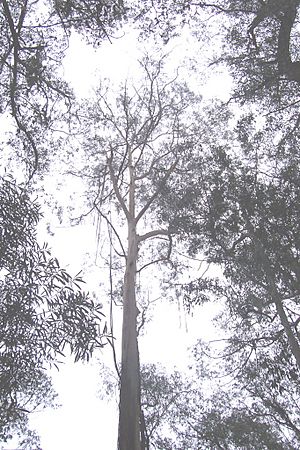Gully gum facts for kids
Quick facts for kids Gully gum |
|
|---|---|
 |
|
| Eucalyptus smithii, Deua National Park, Australia | |
| Scientific classification | |
| Genus: |
Eucalyptus
|
| Species: |
smithii
|
The gully gum, also known as Eucalyptus smithii, is a cool tree found only in southeastern Australia. People also call it the gully peppermint, blackbutt peppermint, or ironbark peppermint. It's usually a medium to tall tree, but sometimes it grows as a smaller, bushy plant called a mallee. This tree has rough bark on its main trunk and smooth, peeling bark higher up. It has long, narrow leaves, white flowers, and fruit shaped like a cup or bell.
Contents
What the Gully Gum Looks Like
Eucalyptus smithii usually grows into a tall tree, reaching about 40–45 m (131–148 ft) high. Sometimes, it grows as a smaller mallee, which is a bushy plant up to 5 m (16 ft) tall.
Bark and Leaves
The tree form has rough, dark grey-brown to black bark on its trunk. This bark is tough and compact. Higher up on the branches, the bark is smooth and white to cream-colored. It peels off in long ribbons. Mallee forms have smooth bark on both their trunks and branches.
Young gully gum plants have leaves that grow in opposite pairs. These leaves are green to greyish and shaped like a narrow spear. They are about 50–110 mm (2.0–4.3 in) long and 6–25 mm (0.24–0.98 in) wide. Their bases wrap around the stem.
Adult leaves grow one after another, not in pairs. They are a slightly shiny green on both sides. These leaves are also narrow and spear-shaped, or sometimes curved. They measure 60–210 mm (2.4–8.3 in) long and 7–16 mm (0.28–0.63 in) wide. The leaf base narrows into a stalk called a petiole, which is 5–28 mm (0.20–1.10 in) long.
Flowers and Fruit
The flowers grow in groups of seven. They appear in the leaf axils, which are the angles between a leaf and the stem. Each group of flowers is on a stalk called a peduncle, about 5–13 mm (0.20–0.51 in) long. Each individual flower bud has a small stalk called a pedicel, 1–6 mm (0.039–0.236 in) long.
Mature flower buds are oval or diamond-shaped. They are 4–6 mm (0.16–0.24 in) long and 3–4 mm (0.12–0.16 in) wide. The top part of the bud, called the operculum, is shaped like a cone or has a beak. Gully gum flowers are white and bloom from December to January.
After flowering, the tree produces woody fruit. This fruit is a capsule shaped like a cup, bell, or half-sphere. It is 3–6 mm (0.12–0.24 in) long and 4–8 mm (0.16–0.31 in) wide. The parts that open to release seeds, called valves, stick out strongly from the rim of the fruit.
Naming the Gully Gum
Eucalyptus smithii was first officially described in 1899. A botanist named Richard Thomas Baker wrote about it in a scientific paper. He used samples collected by William Bäuerlen near Braidwood.
The second part of its scientific name, smithii, honors a chemist named Henry George Smith. He was famous for his early studies on the essential oils found in eucalyptus trees and other Australian plants.
Where Gully Gums Grow
Gully gums grow in southeastern Australia. You can find them in New South Wales, south from Yerranderie, and in eastern Victoria. They prefer shallow soils on slopes near the coast and on tablelands.
In well-watered valleys, they grow as rough-barked trees. On mountains, they might appear as smooth-barked mallees.
How People Use Gully Gums
Gully gums are grown in many places, especially in southern Africa. Their leaves are used to make eucalyptus oil through a process called distillation. This oil is very high in a compound called cineole, which makes up 75–84% of the oil. Cineole gives eucalyptus oil its strong, fresh smell and is used in many products.
This tree also shows good potential for the pulpwood industry. Pulpwood is wood used to make paper and other wood products.
Gallery
See also
 In Spanish: Eucalyptus smithii para niños
In Spanish: Eucalyptus smithii para niños






